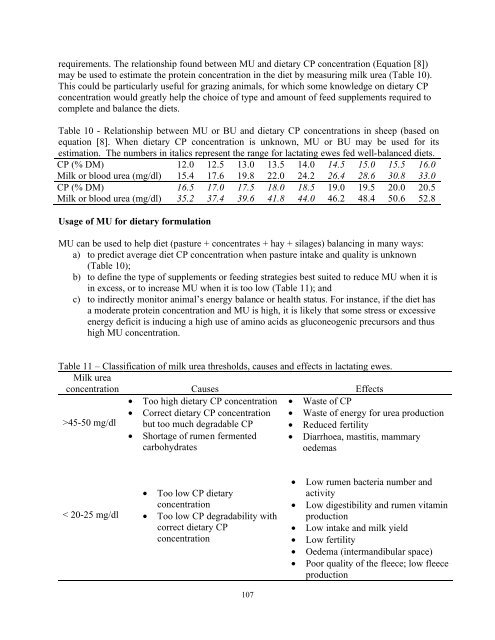Great Lakes Dairy Sheep Symposium - the Department of Animal ...
Great Lakes Dairy Sheep Symposium - the Department of Animal ...
Great Lakes Dairy Sheep Symposium - the Department of Animal ...
You also want an ePaper? Increase the reach of your titles
YUMPU automatically turns print PDFs into web optimized ePapers that Google loves.
equirements. The relationship found between MU and dietary CP concentration (Equation [8])<br />
may be used to estimate <strong>the</strong> protein concentration in <strong>the</strong> diet by measuring milk urea (Table 10).<br />
This could be particularly useful for grazing animals, for which some knowledge on dietary CP<br />
concentration would greatly help <strong>the</strong> choice <strong>of</strong> type and amount <strong>of</strong> feed supplements required to<br />
complete and balance <strong>the</strong> diets.<br />
Table 10 - Relationship between MU or BU and dietary CP concentrations in sheep (based on<br />
equation [8]. When dietary CP concentration is unknown, MU or BU may be used for its<br />
estimation. The numbers in italics represent <strong>the</strong> range for lactating ewes fed well-balanced diets.<br />
CP (% DM) 12.0 12.5 13.0 13.5 14.0 14.5 15.0 15.5 16.0<br />
Milk or blood urea (mg/dl) 15.4 17.6 19.8 22.0 24.2 26.4 28.6 30.8 33.0<br />
CP (% DM) 16.5 17.0 17.5 18.0 18.5 19.0 19.5 20.0 20.5<br />
Milk or blood urea (mg/dl) 35.2 37.4 39.6 41.8 44.0 46.2 48.4 50.6 52.8<br />
Usage <strong>of</strong> MU for dietary formulation<br />
MU can be used to help diet (pasture + concentrates + hay + silages) balancing in many ways:<br />
a) to predict average diet CP concentration when pasture intake and quality is unknown<br />
(Table 10);<br />
b) to define <strong>the</strong> type <strong>of</strong> supplements or feeding strategies best suited to reduce MU when it is<br />
in excess, or to increase MU when it is too low (Table 11); and<br />
c) to indirectly monitor animal’s energy balance or health status. For instance, if <strong>the</strong> diet has<br />
a moderate protein concentration and MU is high, it is likely that some stress or excessive<br />
energy deficit is inducing a high use <strong>of</strong> amino acids as gluconeogenic precursors and thus<br />
high MU concentration.<br />
Table 11 – Classification <strong>of</strong> milk urea thresholds, causes and effects in lactating ewes.<br />
Milk urea<br />
concentration Causes Effects<br />
>45-50 mg/dl<br />
< 20-25 mg/dl<br />
• Too high dietary CP concentration<br />
• Correct dietary CP concentration<br />
but too much degradable CP<br />
• Shortage <strong>of</strong> rumen fermented<br />
carbohydrates<br />
• Too low CP dietary<br />
concentration<br />
• Too low CP degradability with<br />
correct dietary CP<br />
concentration<br />
107<br />
• Waste <strong>of</strong> CP<br />
• Waste <strong>of</strong> energy for urea production<br />
• Reduced fertility<br />
• Diarrhoea, mastitis, mammary<br />
oedemas<br />
• Low rumen bacteria number and<br />
activity<br />
• Low digestibility and rumen vitamin<br />
production<br />
• Low intake and milk yield<br />
• Low fertility<br />
• Oedema (intermandibular space)<br />
• Poor quality <strong>of</strong> <strong>the</strong> fleece; low fleece<br />
production
















